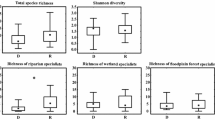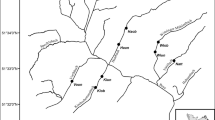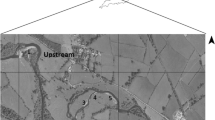Abstract
We investigated the effects of hydromorphological restoration measures (mainly the removal of bank fixations) on riparian mesohabitats, vegetation and carabid beetles by comparing 24 restored to nearby non-restored floodplain sections in Germany. Mesohabitats were recorded along ten equally-spaced transects, plant communities and riparian plant and carabid beetle species along three transects per section. Based on 18 indices including habitat and species diversity, taxonomic diversity and functional indices we compared the frequency and magnitude of changes following restoration, both for the overall dataset and for each site individually. Riparian habitat diversity doubled in restored sections compared to non-restored sections. The numbers of vegetation units and plant and carabid beetle species richness also doubled in restored sections, whereas changes in Shannon diversity were most pronounced for mesohabitats and riparian plants. Taxonomic diversity of carabid beetles decreased in restored sections reflecting post restoration dominance of riparian Bembidion species. Stress-tolerant pioneers of plant and especially carabid species benefit strongly from the re-establishment of open sand and gravel bars, while hygrophilous species, which also include non-riparian species, did not respond to restoration. We conclude that restoring river hydromorphology has almost generally positive effects on riparian habitats and riparian biodiversity. Riparian biota are thus well-suited indicators for the effects of hydromorphological restoration.





Similar content being viewed by others
References
Andersen J (1970) Habitat choice and life history of Bembidiini (Col., Carabidae) on river banks in central and northern Norway. Norsk ent Tidsskr 17:17–65
Andersen J (1978) The influence of the substratum on the habitat selection of Bembidiini (Col., Carabidae). Norw J Entomol 25:119–138
Andersen J (1985) Ecomorphological adaptations of riparian Bembidiini species (Coleoptera, Carabidae). Entomologica Generali 12:41–46
Andersson E, Nilsson C, Johansson M (2000) Effects of river fragmentation on plant dispersal and riparian flora. Regul Rivers Res Manag 89:83–89
Baattrup-Pedersen A, Riis T, Hansen HO, Friberg N (2000) Restoration of a Danish headwater stream: short-term changes in plant species abundance and composition. Aquatic Conserv Mar Freshw Ecosyst 10:13–23
Baattrup-Pedersen A, Friberg N, Larsen SE, Riis T (2005) The influence of channelisation on riparian plant assemblages. Freshw Biol 50:1248–1261
Barber HS (1931) Traps for cave inhabiting insects. J El Mit Sci Soc 46:259–266
Bates AJ, Sadler JP, Fowles AP (2006) Condition-dependent dispersal of a patchily distributed riparian ground beetle in response to disturbance. Oecologia 150:50–60
Bonn A, Hagen K, Wohlgemuth-von Reiche D (2002) The significance of flood regimes for carabid beetle and spider communities in riparian habitats - a comparison of three major rivers in Germany. River Res Applic 18:43–64
Burkart M (2001) River corridor plants (Stromtalpflanzen) in Central European lowland: a review of a poorly understood plant distribution pattern. Global Ecol Biogeogr 10:449–468
Den Boer PJ (1970) On the significance of dispersal power for populations of carabid-beetles (Coleoptera, Carabidae). Oecol 4:1–28
Den Boer PJ (1990) Density limits and survival of local populations in 64 carabid species with different powers of dispersal. J Evol Biol 3:19–48
Desender K (1989) Ecomorphological adaptations of riparian carabid beetles. In: Wouters K, Baert L (eds) Verhandelingen van het Symposium “Invertebraten van België”. Koninklijk Belgisch Instituut voor Natuurwetenschappen, Brussels, Belgium, pp 309–314
Desender K (2000) Flight muscle development and dispersal in the life cycle of carabid beetles: patterns and processes. Bulletin van het Koninklijk Belgisch Instituut voor Natuurwetenschappen. Entomologie 70:13–31
Diekmann M (2003) Species indicator values as an important tool in applied plant ecology–a review. Basic Appl Ecol. 4:493–506
DWD (2010) Climate data for Germany per regions: Time series of regional means. http://www.dwd.de. Cited 16 Jun 2011
Ellenberg H (1974) Zeigerwerte der Gefäßpflanzen Mitteleuropas. Scr Geobot 9:1–97
Ellenberg H (1996) Vegetation Mitteleuropas mit den Alpen in ökologischer, dynamischer und historischer Sicht. 5. Auflage, Ulmer-Verlag, Stuttgart
Eyre MD, Luff ML, Phillips DA (2001) The ground beetles (Coleoptera: Carabidae) of exposed riverine sediments in Scotland and northern England. Biodivers Conserv 10:403–426
Follner K, Henle K (2006) The performance of plants, molluscs, and carabid beetles as indicators of hydrological conditions in floodplain grasslands. Int Rev Hydrobiol 91:364–379
Gerisch M (2011) Habitat disturbance and hydrological parameters determine the body size and reproduction strategy of alluvial ground beetles. Zookeys 100:353–370
Gerisch M, Schanowski A, Figura W, Gerken B, Dziock F, Henle K (2006) Carabid beetles (Coleoptera, Carabidae) as indicators of hydrological site conditions in floodplain grasslands. Int Rev Hydrobiol 91:326–340
Gesellschaft für Angewandte Carabidologie (2009) Lebensraumpräferenzen der Laufkäfer Deutschlands–Wissensbasierter Katalog. Angew Carab Suppl 5:45
Gilvear D, Willby N (2006) Channel dynamics and geomorphic variability as controls on gravel bar vegetation; River Tummel, Scotland. River Res Appl 22:457–474
Godreau V, Bornette G, Frochot B, Amoros C, Castella E, Oertli B, Chambaud F, Oberti D, Craney E (1999) Biodiversity in the floodplain of Saone: a global approach. Biodivers Conserv 8:839–864
Greenwood MT, Bickerton MA, Castella E, Large ARG, Petts GE (1991) The use of coleoptera (arthropoda: insecta) for floodplain characterization on the River Trent, UK. Regul Rivers Res Manag 6:321–332
Günther J, Assmann T (2005) Restoration ecology meets carabidology: effects of floodplain restitution on ground beetles (Coleoptera, Carabidae). Biodivers Conserv 14:1583–1606
Gurnell A, Goodson J, Thompson K, Clifford N, Armitage P (2007) The river-bed: a dynamic store for plant propagules? Earth Surf Proc Land 32:1257–1272
Hering D, Borja A, Carstensen J, Carvalho L, Elliott M, Feld CK, Heiskanen A-S, Johnson RK, Moe J, Pont D, Solheim AL, Van de Bound W (2010) The European Water Framework Directive at the age of 10: a critical review of the achievements with recommendations for the future. Sci Total Environ 408:4007–4019
Jähnig SC, Lorenz AW, Hering D (2008) Hydromorphological parameters indicating differences between single-and multiple-channel mountain rivers in Germany, in relation to their modification and recovery. Aquatic Conserv Mar Freshw Ecosyst 18:1200–1216
Jähnig SC, Brunzel S, Gacek S, Lorenz AW, Hering D (2009) Effects of re-braiding measures on hydromorphology, floodplain vegetation, ground beetles and benthic invertebrates in mountain rivers. J Appl Ecol 46:406–416
Johansson ME, Nilsson C, Nilsson E (1996) Do rivers function as corridors for plant dispersal? J Veg Sci 7:593–598
Klotz S, Kühn I (2002) Ökologische Strategietypen. Schriftenreihe für Vegetationskunde, Bundesamt für Naturschutz, Bonn 38:197–201
Koch K (1989) Die Käfer Mitteleuropas. Ökologie. Band E1. Carabidae–Micropeplidae. Spektrum Akademischer Verlag, Heidelberg, p 440
Kotze DJ, Brandmayr P, Casale A, Dekoninck W, Koivula MJ, Lövei GL, Mossakowski D, Noordijk J, Paarmann W, Pizzolotto R, Saska P, Schwerk A, Serrano J, Szyszko J, Taboada A, Turin H, Venn S, Vermeulen R, Zetto T (2011) Forty years of carabid beetle research in Europe—from taxonomy, biology, ecology and population studies to bioindication, habitat assessment and conservation. Zookeys 100:55–148
Lambeets K, Vandegehuchte ML, Maelfait J-P, Bonte D (2008a) Understanding the impact of flooding on trait-displacements and shifts in assemblage structure of predatory arthropods on river banks. J Anim Ecol 77:1162–1174
Lambeets K, Hendrickx F, Vanacker S, Van Looy K, Maelfait J-P, Bonte D (2008b) Assemblage structure and conservation value of spiders and carabid beetles from restored lowland river banks. Biodivers Conserv 17:3133–3148
Lambeets K, Vandegehuchte ML, Maelfait J-P, Bonte D (2009) Integrating environmental conditions and functional life-history traits for riparian arthropod conservation planning. Biol Conserv 142:625–637
Manderbach R, Hering, D (2001) Typology of riparian ground beetle communities (Coleoptera, Carabidae, Bembidion spec.) in Central Europe and adjacent areas. Arch Hydrobiol 4:583–608
Müller-Motzfeld G (2004) Adephaga 1: Carabidae (Laufkäfer). In: Freude H, Harde KW, Lohse GA, Klausnitzer B (eds) Die Käfer Mitteleuropas Bd. 2. Spektrum Verlag, Heidelberg
Naiman RJ, Décamps H (1997) The ecology of interfaces: riparian zones. Annu Rev Ecol Syst 28:621–658
Naiman RJ, Décamps H, McClain ME (2005) Riparia—ecology, conservation, and management of streamside communities. Elsevier Academic Press, San Diego
Nilsson C, Svedmark M (2002) Basic principles and ecological consequences of changing water regimes: riparian plant communities. Environ Manag 30:468–480
Oberdorfer E (1983, 1992) Süddeutsche Pflanzengesellschaften. Teil I-III. Fischer, Stuttgart, Germany
Paetzold A, Yoshimura C, Tockner K (2008) Riparian arthropod responses to flow regulation and river channelization. J Appl Ecol 45:894–903
Palmer MA, Menninger HL, Bernhardt E (2010) River restoration, habitat heterogeneity and biodiversity: a failure of theory or practice? Freshw Biol 55:205–222
Rainio J, Niemelä J (2003) Ground beetles (Coleoptera: Carabidae) as bioindicators. Biol Conserv 12:487–506
Raven PJ, Fox P, Everard M, Holmes NTH, Dawson FH (1997) River habitat survey: a new system for classifying rivers according to their habitat quality. In: Boon PJ, Howell DL (eds) Freshwater quality: defining the indefinable. The Stationary Office Edinburgh, Edinburgh, pp 215–234
Renner K (1980) Faunistisch-ökologische Untersuchungen der Käferfauna pflanzensoziologisch unterschiedlicher Biotope im Evessell-Bruch bei Bielefeld-Sennestadt. Berichte des Naturwissenschaftlichen Vereins Bielefeld Sonderheft 2:145–176
Renöfält BM, Nilsson C, Jansson R (2005) Spatial and temporal patterns of species richness in a riparian landscape. J Biogeogr 32:2025–2037
Riis T (2008) Dispersal and colonisation of plants in lowland streams: success rates and bottlenecks. Hydrobiologia 596:341–351
Rohde S, Schütz M, Kienast F, Englmaier P (2005) River widening: an approach to restoring riparian habitats and plant species. River Res Appl 21:1075–1094
Sadler J, Bell D, Fowles A (2004) The hydroecological controls and conservation value of beetles on exposed riverine sediments in England and Wales. Biol Conserv 118:41–56
Soons MB (2006) Wind dispersal in freshwater wetlands: knowledge for conservation and restoration. Appl Veg Sci 9:271–278
Tabacchi E, Correll DL, Hauer R, Pinay G, Planty-Tabacchi A-M, Wissmar RC (1998) Development, maintenance and role of riparian vegetation in the river landscape. Freshw Biol 40:497–516
Tockner K, Bunn SE, Gordon C, Naiman RJ, Quinn GP, Stanford JA (2008) Flood plains: critically threatened ecosystems. In: Polunin NVC (ed) Aquatic ecosystems. Trends and global prospects. Cambridge University Press, New York, pp 45–61
Trautner J (1992) Laufkäfer - Methoden der Bestandsaufnahme und Hinweise für die Auswertung bei Naturschutz- und Eingriffsplanungen. In: Trautner J (ed) Arten- und Biotopschutz in der Planung: Methodische Standards zur Erfassung von Tierartengruppen [BVDL-Tagung Bad Wurzach, 9.-10. November 1991]. Ökologie in Forschung und Anwendung 5:145–162
Trautner J (1999) Handfänge als effektive und vergleichbare Methode zur Laufkäfer-Erfassung an Fließgewässern—Ergebnisse eines Test an der Aich (Baden-Württemberg). Angew Carab Suppl 1:139–144
Van Looy K, Vanacker S, Jochems H, De Blust G, Dufrêne M (2005) Ground beetle habitat templets and riverbank integrity. River Res Appl 21:1133–1146
Vannote RL, Minshall GW, Cummins KW, Sedell JR, Cushing CE (1980) River continuum concept. Can J Fish Aquat Sci 37:130–137
Warwick RM, Clarke KR (1995) New “biodiversity” measures reveal a decrease in taxonomic distinctness with increasing stress. Mar Ecol Prog 129:301–305
WFD (2000) Water Framework Directive (2000/60/EC). http://eur-lex.europa.eu. Cited 26 Jan 2011
Wintle BC, Kirkpatrick JB (2007) The response of riparian vegetation to flood-maintained habitat heterogeneity. Austral J Ecol 32:592–599
Acknowledgments
This study was supported by Bundesamt für Naturschutz (FKZ 3507 85 050-K1) and Deutsche Bundesstiftung Umwelt (FK 25032-33/2). We thank researchers of the Department of Limnology and Conservation, Research Institute and Natural History Museum Senckenberg for the realization of field work on some streams in Hesse. We are grateful to Sonja Jähnig for providing data on three restoration measures at the Lahn and to Karsten Hannig for his support in carabid identification.
Author information
Authors and Affiliations
Corresponding author
Electronic supplementary material
Below is the link to the electronic supplementary material.
Rights and permissions
About this article
Cite this article
Januschke, K., Brunzel, S., Haase, P. et al. Effects of stream restorations on riparian mesohabitats, vegetation and carabid beetles. Biodivers Conserv 20, 3147–3164 (2011). https://doi.org/10.1007/s10531-011-0119-8
Received:
Accepted:
Published:
Issue Date:
DOI: https://doi.org/10.1007/s10531-011-0119-8




